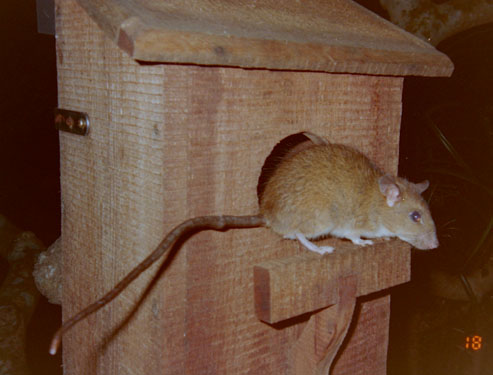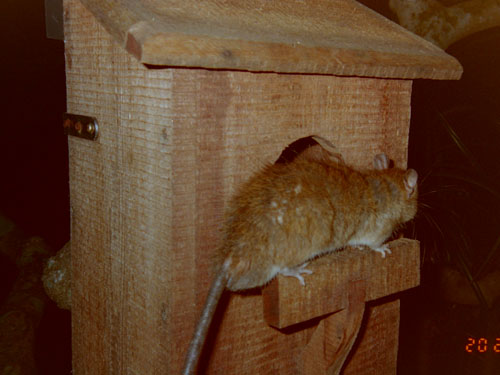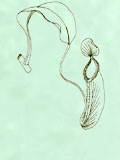
Vertebrates (pdf)
Rattus sikkimensis occupies bird nest box on Kau Sai Chau
by Thomas D. Dahmer
Ecosystems Ltd., 2/F Kingsun Computer Bldg., 40 Shek Pai Wan Road, Aberdeen, Hong Kong, ecosys@pacific.net.hk
Introduction
Kau Sai Chau is an island of 6.7 km2 area near Sai Kung in northeast Hong Kong. The northern third of the island was developed by the Hong Kong Jockey Club in 1994-5 as Hong Kong’s first public golf course. Mammalian species on the island have been recorded since 1993 for an environmental impact assessment and subsequent monitoring studies. This note reports the results of one monitoring session carried out in October 2003 to identify a mammal that occupied a bird nest box installed some 6 months earlier. Eleven bird nest boxes were installed in trees at Kau Sai Chau in April 2003 with the objective of providing habitat for cavity-nesting birds. During monitoring of the nest boxes it was noted that one contained wood shavings and various fruits that had been gnawed to access seeds. It was evident that the box was occupied by a mammal rather than a bird.
Methods
Mammals have been monitored on Kau Sai Chau by visual survey for animals, their sign, or remains; live-trapping using Sherman® aluminium live-traps, locally made wire-mesh rat-traps and Tomahawk® live traps; spot-lighting; and photography using camera-traps. Camera-traps were used to identify the unknown mammalian occupant of the nest box. The camera-traps were assembled from Model 550 TrailMaster® passive infrared monitors and Canon A1/Prima AS-1 SureShot® automatic cameras suitable for use on land or in water. Monitors were set at a pulse sensitivity of 3 (3 infrared pulses required to record an event; approximately 0.05 seconds/pulse or 0.15 seconds in total) and a pulse interval of 4 seconds (maximum time interval for recording the 3 pulses). Event delay (time delay between recorded events) was set at 30 seconds. Camera delay (time lag between photographs) was set at 30 seconds. Cameras were set on full-time flash mode. Two cameras and two monitors were used at the nest box site. Cameras were loaded with 35 mm 400 ASA Kodak® print film, and the negatives were later digitized using a Nikon CoolPix® 995 digital camera and digitizing adapter. Camera-traps were deployed because it was considered possible that the unidentified species using the nest box was a new rodent species for Kau Sai Chau and might not be captured in conventional rodent live-traps.
Results
Mammals recorded before and after construction of the golf course are listed in Table 1. All three rodent species had been live-trapped and identified prior to the camera trapping session in October 2003. However, prior to October 2003 no tree-dwelling mammals other than bats were thought to occupy the island.
Photographs taken within 4 days of installation of the camera-traps are shown as Figures 1 and 2. The occupant of the nest box was determined to be Rattus sikkimensis (Wilson and Reeder 1992; R. remotus per Corbett and Hill 1992), a common rat species in Hong Kong (Chung 2003). No other species was photographed entering or leaving the nest box during the initial 5-day trapping session or during a 6-day session that begun one week later. This was the first recorded instance of tree nesting by any Rattus species on the island.
The tree supporting the nest box was a Schefflera heptaphylla of approximately 25 cm diameter at breast height. The nest box was installed with the entrance at 3.5 m above the ground surface. The surrounding habitat was a 3-4 ha mixed species stand of mainly broadleaved evergreen woodland approximately 20-25 years in age that was left undisturbed during construction of the golf courses. The canopy was dense enough to enable rats to move between trees along branches rather than by descending to ground level. The nest box was filled to a depth of some 10 cm with shavings, shreds, and other bits of wooden material brought in from outside.
The TrailMaster® passive infrared monitor proved useful in this circumstance because its sensitivity could be adjusted to maximize the probability of sensing a small mammal suspected to be capable of rapid movement in and out of the range of the sensor. Camera-trapping proved a useful method for species identification in this case because: (i) although the species was unknown, its area of activity (nest box) could be readily identified and targeted; (ii) the risks of theft or vandalism of equipment were considered low; (iii) photography of the subject at a tree nest was considered more probable than capture by live-trapping.
 |
| Fig. 1. Rattus sikkimensis at nest box entrance on 18 October 2003 at 0219 hrs (entrance diameter = 7 cm). |
 |
| Fig. 2. Rattus sikkimensis at nest box entrance on 20 October 2003 at 2333 hrs (entrance diameter = 7 cm). |
Acknowledgements
Mammal observations were often reported by personnel at The Jockey Club Kau Sai Chau Public Golf Course Ltd. Their cooperation and assistance are greatly appreciated. Studies reported here were funded by The Jockey Club Kau Sai Chau Public Golf Course Ltd., whose support is gratefully acknowledged. The Agriculture, Fisheries and Conservation Department (AFCD) of the Government of Hong Kong Special Administrative Region authorised permits for live-capture of wild animals. This support is gratefully acknowledged. Kylie Chung, Department of Ecology and Biodiversity, The University of Hong Kong, confirmed the identification of Rattus sikkimensis. Her contribution and that of her supervisor, Dr. Richard Corlett, are gratefully acknowledged. This note is dedicated to the memory of Stephen Jay Gould, who believed, as does the author, in the heuristic value of unforeseen outcomes.
Table 1 Mammals recorded on Kau Sai Chau from May 1993 through October 2003.
|
Pre-Construction Records - May 1993 to May 1994 |
|||
|
Class, Order, Family |
Common Name |
Scientific Name |
Year First |
|
Carnivora, Canidae |
Feral Dog |
Canis familiaris |
1993 |
|
Carnivora, Viverridae |
Small Indian Civet |
Viverricula indica |
1993 |
|
Artiodactyla, Suidae |
Wild Boar |
Sus scrofa |
1994 |
|
Rodentia, Muridae |
Norway Rat |
Rattus norvegicus |
1994 |
|
Post-Construction Records - July 1995 through October 2003 |
|||
|
Order, Family |
Common Name |
Scientific Name |
Year First Recorded |
|
Chiroptera, Rhinolophidae |
Himalayan Leaf-nosed Bat |
Hipposideros armiger |
2000 |
|
Chiroptera, Vespertillionidae |
Pipistrelle |
Pipistrellus sp. |
2000 |
|
Carnivora, Canidae |
Feral Dog |
Canis familiaris |
1995 |
|
Carnivora, Viverridae |
Small Indian Civet |
Viverricula indica |
1993 |
|
Masked Palm Civet |
Paguma larvata |
2001 |
|
|
Artiodactyla, Suidae |
Wild Boar |
Sus scrofa |
1996 |
|
Rodentia, Muridae |
Norway Rat |
Rattus norvegicus |
1994 |
|
Lesser Ricefield Rat |
Rattus losea |
2000 |
|
|
Sikkim Rat |
Rattus sikkimensis |
2000 |
|
|
Rodentia, Hystricidae |
Chinese Porcupine |
Hystrix hodgsoni |
2002 |
Bibliography
Chung, K. (2003). Hong Kong’s common rat species. Porcupine! 29:11-12. Newsletter of the Department of Ecology & Biodiversity, The University of Hong Kong, Hong Kong Special Administrative Region.
Corbett. G.B. & Hill, J.E. (1992). The Mammals of the Indomalayan Region: A Systematic Review. Natural History Museum Publications, Oxford Univ. Press, Oxford. 488 pp.
Wilson, D.E. & Reeder, D.M. (eds.). (1992). Mammal Species of the World: a Taxonomic and Geographic Reference. 2nd ed. Smithsonian Institution Press, Washington, D.C. 1206 pp.
|
|
P.12-14 |
|
Porcupine! |
 Copyright © 2000 |
